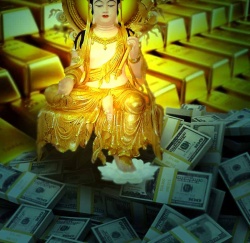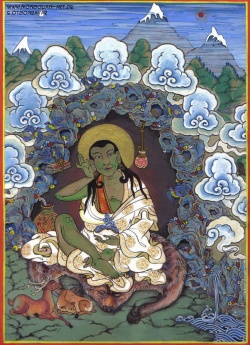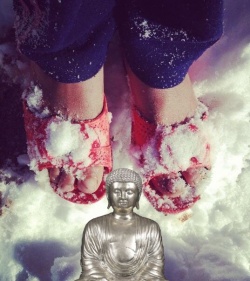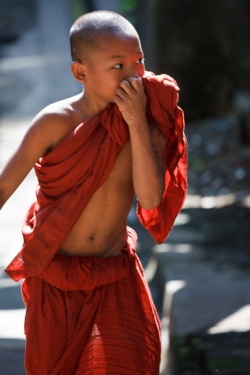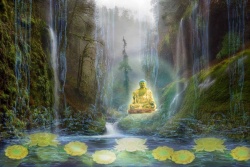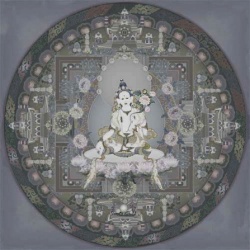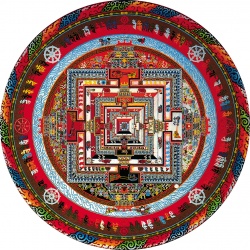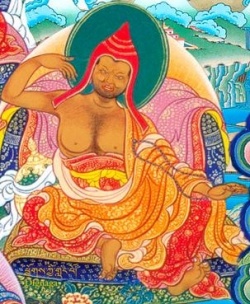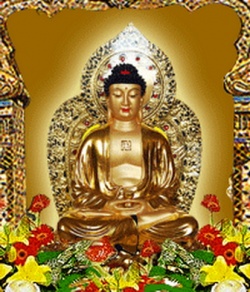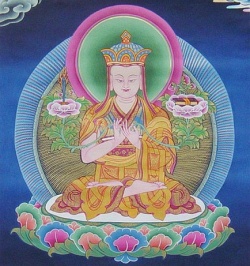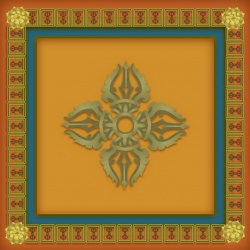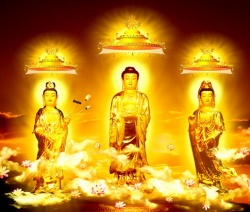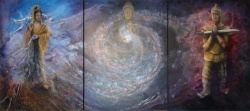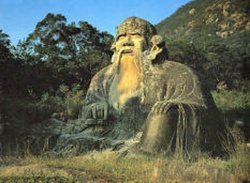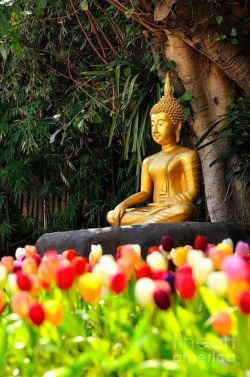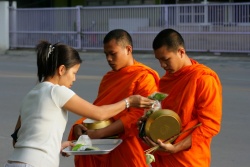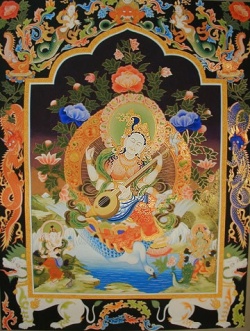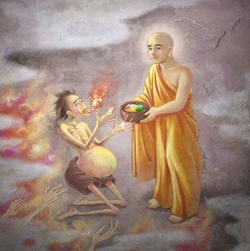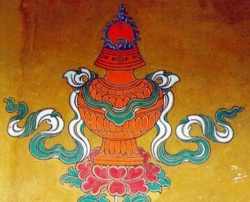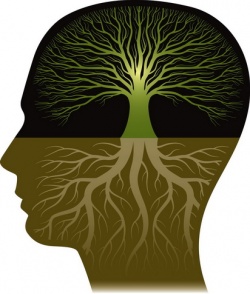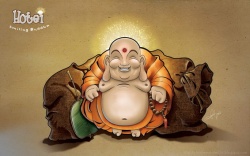DECISION OF THE INDIAN SUPREME COURT - 20
This decision was the culmination of the case that the Karmapa Charitable Trust filed in 1998 to regain control of Rumtek monastery. In this decision, given in the case of Tsurphu Labrang vs. Karmapa Charitable Trust and Ors., announced in New Delhi on July 5, 2004, the court refused to hear the appeal of the Tsurphu Labrang, a group created by Gyaltsab Rinpoche and Tenzin Namgyal to represent the claims of followers of Ogyen Trinley to manage Rumtek in legal proceedings. The court rejected their Special Leave Petition to this effect. By thus refusing to interfere in the earlier decision of the Sikkim District Court and a subsequent confirmation by the High Court in New Delhi, the Supreme Court allowed the original decision to stand -- meaning that the Tsurphu group had no legal claim to Rumtek, and that the Karmapa Charitable Trust was the only group recognized to manage the monastery.
SLP(C)No. 22903 OF 2003
ITEM No. 41 Court NO.5 SECTION XIV
A/N MATTER
SUPREME COURT OF INDIA
RECORD OF PROCEEDINGS
Petition(s) for Special Leave to Appeal (Civil) No. 22903/2003
(From the judgement and order dated 26/08/2003 in WP 5/03 of The HIGH COURT OF SIKKIM at Gangtok)
TSHURPHU LABRANG Petitioner(s)
VERSUS
KARMAPA CHARITABLE TRUST & ORS. Respondent(s)
(With Appln(s). for permission to place addl. documents Vol. III to VI and exemption from filing O.T. and clarification and directions and with prayer for interim relief and office report)
Date: 05/07/2004 This Petition was called on for hearing today.
CORAM:
HON'BLE MR. JUSTICE S.N. VARIAVA
HON'BLE MR. JUSTICE ARIJIT PASAYAT
For Petitioner(s) Mr. A.B. Saharya, Sr. Adv.
Mr. Sudarshan Misra, Sr. Adv.
Mr. Naresh Mathur, Adv.
Mr. Sudarsh Menon, Adv.
For Respondent (s) Mr. Parag Tripathy, Sr. Adv.
Mr. Parveen Agarwal, Adv.
Mr. Somnath Mukherjee, Adv.
Mr. S.S. Hamal, Adv.
Mr. Kamal Jetely, Adv.
Mr. Gurpreet Singh, Adv.
Mr. Jayant, Adv.
Mr. Harish N. Salve, Sr. Adv.
Mr. Deepak K. Thakur, Adv.
Mr. K.V. Mohan, Adv.
Mr. Brijender Chahar, Adv.
Mrs. Jyoti Chahar, Adv.
Mr. Ashok Mathur, Adv.
UPON hearing counsel the Court made the following ORDER
Mr. B.S. Chahar, learned counsel states that the State of Sikkim does not desire to file affidavit.
We see no reason to interfere. The Special Leave Petition is dismissed.
We, however, clarify that the trial court will not take into consideration any observations made in the impugned order or in the order of the District Judge dismissing the application.
(K.K. Chawla) Court Master
(Jasbir Singh) Court Master
ANALYSIS OF TAI SITU'S PREDICTION LETTER
At a meeting of the Karmapa Search Committee held at Rumtek on March 19, 1992, Tai Situ Rinpoche presented a letter that he claimed was given to him by the sixteenth Karmapa before his death. After the meeting, the Rumtek administration made a detailed study of the letter to determine its authenticity. Below are their major findings, as published in The Karmapa Papers, 71-73.
RECENT EVENTS
Documents: The letter
Analysis of the Prediction Letter
As mentioned earlier, there have been doubts expressed about the letter presented by Situ Rinpoche on March 19, 1992. Is it the authentic testimonial letter of H.H. the 16th Gyalwa Karmapa?
Unfortunately, we only had a copy of the letter, not the original. Nevertheless we examined the copy to see what might have brought about these doubts. Some seem to suspect Situ Rinpoche of having written the letter himself, so we included in our analysis those of his letters available to us.
General remarks about the letter:
In several places the text seems to be damaged by humidity. Traces of a vertical fold can be seen in the middle of the paper. Horizontally the letter seems to have been folded in at least three places below the third and the eighth line of the text and above the seal. This last fold can also be deduced because traces of the seal are found above it.
Although the writing in the part above the seal is blurred to such an extent as to be illegible, there seem to be no traces of ink on the seal itself.
Fortunately, we had more than 30 letters handwritten by H.H. the 16th Karmapa dating from the 1970s to 1981, shortly before he passed away. We asked several Tibetans for comparison who confirmed that the letter at first sight, looked as if it were written by His Holiness. But this impression seemed to vanish the more they went into details, especially for people very familiar with the H.H. the 16th Karmapa's handwriting. What follows are comparisons as to: 1) the signature, 2) the handwriting and spelling, 3) the letterhead.
1) Signature:
The signature on the letter is almost entirely covered by the seal. From what little was visible on our copy, the signature might be different from those we found on H.H. the 16th Karmapa's letters. This impression is strengthened when the signatures are superimposed by computer.
Signature on the prediction letter
Examples of Karmapa's signature as found on his letters
2) Handwriting and Spelling:
Only a forensic test of the original letter could definitely prove whether the handwriting on the letter is that of H.H. the 16th Karmapa or not.
Nevertheless we compared the handwriting of the letter with that of Karmapa and Situ Rinpoche. There seem to be differences between the script in the letter and the handwriting in Karmapa's letters we had. On the other hand, one could find similarities when comparing the letter's script with Situ Rinpoche's handwriting (see two examples in the tables below; the syllables used for comparison are marked in the respective letters).
For differences in the spelling of the word "drub" see table below. In line 6 of the letter, this word is written with the second postscript 'sa'. We did not find this misspelling in any of H.H. Karmapa's letters, whereas it is to be found in a letter by Situ Rinpoche (see Doc. T5)
as written by H.H. the 16th Karmapa as written by Situ Rinpoche as written in "the" letter
the syllable "phyogs"
two examples of the vocal "e"
the syllable "drub"
The above examples were taken from the letters below: (see Part D, 4 for enlarged reproductions):
The letter
letter by Situ Rinpoche
Letter by Situ Rinpoche
Three letters of H.H. 16th Karmapa
3) The Letterhead:
We found different letterheads on H.H. the Gyalwa Karmapa's letters available to us. On several examples the emblem in the middle (two antelopes and the dharma wheel) was the same as in document T27. In some cases, it was multicoloured. In others monochrome red. On most of the letters however one could see the more elaborate emblem also used in the letters. Sometimes the words 'His Holiness the Gyalwa Karmapa' were written in italics as shown in Doc T27. In other cases, these words and the address were lightly italicised as shown below in example III. In few instances the words 'His Holiness the Gyalwa Karmapa' were written in the middle of the page, just below the emblem.
None of Karmapa's letters available to us had a letterhead identical to the one on the letter, even though the more elaborate emblem shown there was often used:
In no case did we find the words 'His Holiness the Gyalwa Karmapa' printed as in the letter, where the distance between the words is unusually big.
In our copy of the letter the words 'His' and 'the' are not in line with the rest of the text. Perhaps this was just a problem with the photocopier.
The characters themselves in the letter are different from those in the Karmapa's original letters. Especially the letters 'S' as in 'Holiness' and 'P' as in 'Karmapa' are broader in the letter's letterhead than in any of Karmapa's letterheads available to us. As a matter of fact, only in some of the International Kagyu Headquarters' letterheads (see example IV below) did we find the exact same script as in the letter.
I
II
III
IV
RAO REPORT TO THE INDIAN CABINET ON THE COUP AT RUMTEK MONASTERY
On May 24, 1997, K. Sreedhar Rao, an Indian government official stationed in Sikkim, submitted a fourteen-page report to the secretary of the Indian cabinet in New Delhi, T.S.R. Subramaniam. The report was marked "secret" on each page and its subject was the situation at Rumtek and its implications for relations between India and China. Rao began his term as chief secretary during N.B. Bhandari's final term as chief minister of Sikkim. But unlike officials of the local government, Rao was not elected by Sikkim voters or appointed by Bhandari. Under India's federal system, a chief secretary serves as the representative of the central government in each of India's twenty-eight states, and the office is filled by appointment from New Delhi. Thus, as a federal appointee, Rao was independent of the local Sikkim administration and was able to criticize its behavior when he concluded that it threatened the national security interests of the country as a whole. The text of his report is reproduced in full below, staring with Rao's original cover letter.
K. SREEDHAR RAO, IAS
CHIEF SECRETARY
CAMP: Government of Sikkim
Sikkim House
12, Panchsheel Marg
Chanakyapuri, New Delhi 110021
No. SM/4(2)/CS/
Dated: 24.5.1997
Dear Shri
I had sent a brief report to you on the Rumtek situation on 10.12.96. Taking into account certain recent developments I have carried out a more derailed assessment outlining possible options before us. I am sending herewith this assessment for your kind perusal. I am endorsing copies of this both to the DIB and the Chairman JIC with whom I have discussed this matter.
Yours sincerely,
Sd/
(K. SREEDHAR RAO)
SHRI T.S.R. SUBRAMANIAM,
Cahinet Secretary,
Government of India,
NEW DELHI.
A REPORT ON RUMTEK MONASTERY-SIKKIM
The controversy regarding the reincarnation of the seventeenth Gyalwa Karmapa has been persisting ever since 1992. Recently, the arrival of the Karmapa, recognized by the Shamar Rinpoche faction, in Kalimpong (Darjeeling District) has caused considerable apprehension among the members of the Joint Action Committee in Sikkim who have been advocating the cause of the Karmapa reincarnate in Tibet, recognized by the Tai Situ Rinpoche group. There are reports to indicate that the Joint Action Committee is planning to send a delegation to Tibet in an effort to bring the Karmapa incarnate from Tibet to Rumtek. This group is being supported by Lamas not only from the Rumtek monastery but also reportedly by Lamas from Phodong, Ralang and even Pemyangtse monastery, even though the Pemyangtse monastery does not belong to the Karmapa sect. These developments have made it necessary to comprehensively assess the matter in order to develop a suitable strategy to deal with the emerging situation.
Genesis Of The Problem
On the demise of the sixteenth Karmapa in 1981, the affairs of the Rumtek monastery were managed by four regents, namely, Tai Situ Rinpoche, Jamgon Kongtrul Rinpoche, Tsurphu Gyaltsab Rinpoche and Shamar Rinpoche. Of these four regents Shamar Rinpoche being related to the sixteenth Karmapa is believed to be a higher reincarnate Lama occupying a position next only to the Karmapa himself, whereas the other regents occupy lower position in hierarchy. While the monastery's affairs with respect to religious practices were to be looked after by these four regents, the temporal affairs of the monastery were to be looked after by a trust. Before the demise of the sixteenth Karmapa he was the sole trustee and after his demise, a body of seven trustees was constituted and duly registered to manage the affairs of the monastery and its property. Shamar Rinpoche, Tai Situ Rinpoche, Jamgon Kongtrul Rinpoche and Jigdal Densapa (a former Additioinal Chief Secretary of Govt. of Sikkim), Mr. Gyaltshen (another ex-bureaucrat), Topga Yugyal from Bhutan, a representative of Dabur and Company and Gyan Jyoti from Nepal were all the trustees. This body of trustees used to meet regularly after the demise of the Gyalwa Karmapa and the affairs of the monastery and its properties were being administered in an organized manner. This trust consisting of the above mentioned trustees continues to exist and has been as mentioned above duly registered in India.
The task of finding the seventeenth reincarnate Gyalwa Karmapa however was the collective responsibility of the four regents mentioned above.
In March, 1992 Tai Situ Rinpoche appears to have declared that the letter of prediction about the reincarnation left behind by the Gyalwa Karmapa has been found and the regents should take action to find the reincarnation in accordance with the letter. The regents had apparently met and studied the letter and informed some lay people as also the trustees, of the discovery. However, it is reported that even at that point of time the authenticity ot the letter was questioned by some of the trustees and more particularly by Shamar Rinpoche who had pointed out that the letter was not in the handwriting of the sixteenth Gyalwa Karmapa, that there are a number of grammatical and other errors and there could be doubts whether the letter was written prior to the demise of the sixteenth Gyalwa Karmapa. It appears that in view of this doubt the regents resolved to consider the matter further and postponed a decision on the identification of the reincarnation for about seven months. In fact a demand seems to have been ralsed that this letter supposedly left behind by the sixteenth Karmapa should be subjected to a forensic test but Tai Situ was evasive about this.
In spite of the agreed waiting period mentioned above, taking advantage of the absence of Shamar Rinpoche, the Tai Situ group seems to have organized an expedition to Tibet to identify the reincarnation. This was a violation of the collective responsibility that had been cast upon the four regents to find the reincarnation. In the meanwhile one of the regents, namely, Jamgon Kongtrul met with an accident and died allegedly under suspicious circumstances. It is also alleged that the Government of Sikkim did not conduct a proper inquiry into the matter. Normally, the identification of a reincarnation is apparently a fairly detailed and lengthy procedure involving a number of tests. Reportedly the whole identification in Tibet was carried through in Tibet within a very short while and the reincarnation was taken from the village Bakor in the Kham province of Tibet where the identification took place, to Lhasa and then on to Tsurphu monastery, the original seat of the Karmapas, and formally installed with the active assistance of the Chinese authorities. It is also reported that the reincarnation accompanied by Tai Situ Rinpoche was given a highly visible, ostentatious reception by the Chinese in Lhasa as well as in the Tsurphu monastery.
Having installed the reincarnate in Tsurphu monastery, a message was sent to His Holiness the Dalai Lama who was then in Brazil attending the Rio Earth Summit. The Dalai Lama accepted the discovery as the reincarnation of the sixteenth Gyalwa Karmapa possibly because it was claimed that the reincarnation had been identified unanimously and there was no controversy whatsoever.
The reason as to why His Holiness the Dalai Lama approved the reincarnation in a hurried manner and that also without adequate evidence and proper verification needs to be analyzed. It is possible that a small coterie around him had been influenced by the Chinese. This belief is reinforced by the fact that this small group has influenced His Holiness to continue to support the Tai Situ group even though the Dalai Lama himself has been briefed about the controversy and the lack of unanimity with respect to the reincarnation. The second explanation could be that Dalai Lama was at that point of time carrying on delicate negotiations with the Chinese with respect to Tibet and he was influenced to think that such a recognition may go in his favor during his further discussions with the Chinese. A third explanation put forth by the religiously inclined is that the Dalai Lama heads the Gelug Sect which is not favorably inclined towards the Kagyu sect particularly because of the growing influence of the Kagyu sect. (After the establishment of the Dharma Chakra Center in Rumtek in the early 1960s, the Karmapa sect has opened not less than 600 centers all over the world). The fourth explanation is that the recognition given by the Dalai Lama is not a religious recognition but basically a temporal act placing the Karmapa in a hierarchy next to the Dalai Lama and the Panchen Lama. It is an act which need not be given any religious significance. While this matter needs to be studied in more detail, what is important to note is that following the recognition of the Karmapa in Tibet and its approval by the Dalai Lama, the People's Republic of China put their seal of approval on the reincarnation. This. is perhaps the first time that the People's Republic of China has given such an approval and is possibly calculated to demonstrate to the world the decisive say that the People's Republic of China have in the affairs of the Tibet both spiritual and temporal.
It would appear from the above analysis that the Tai Situ Rinpoche group had managed to get their candidate approved by the Dalai Lama as well as the PRC in spite of the fact that there were fundamental doubts about the correctness of the so-called instructions left behind by the sixteenth Gyalwa Karmapa. Since then the Tai Situ Rinpoche group has been influencing local opinion in Sikkim to continuously pressurize the authorities for bringing the Karmapa reincarnate to Rumtek and formally install him in the monastery.
The Chinese Connection And Role Of Tai Situ Rinpoche
It would appear from the above that Tai Situ Rinpoche group had wittingly or unwittingly played into the hands of the Chinese. However, reports indicate that the Tai Situ who is a Tibetan national had been visiting Tibet on and off and in 1984-85 he traveled extensively and drafted a program for so-called development of his country. He records that "at the end of 1984 and beginning of 1985 I visited for four months my country (meaning China) after 26 years abroad and traveled to the areas of Sitron Tsongol, Gangsheo Yunnan and Shingkjang." The development program includes education, healthcare, culture, handicrafts, increase in income and living standards, etc. What is noteworthy is that throughout his report he talks about friendly connections between the Chinese and the people of other countries, study of the Chinese language and study of Chinese medicine. He talks about Chinese in the most friendly terms referring to the Chinese as Chinese brothers. He talks about Chinese brothers living abroad as well. He talks about the autonomous region of Tibet and indicates that his plan has the honest intention to benefit the people of China and in particular the autonomous region of Tibet, Sitron, Yunnan, Gangshuo, etc. He profusely thanks the two leaders of China, namely, Hu Yao Ban and Deng Xiao Peng as well as other leaders of China for their excellent political stance. The report of Tai Situ Rinpoche is addressed to the Director of Chinese Communist Government. All this indicates that Tai Situ had built up a good relationship with the Chinese possibly from 1984.
It would be appropriate to consider the Chinese interest in this entire matter at this stage. From the time of Chinese occupation and indeed after the departure of Dalai Lama from Tibet, the Chinese have been strengthening their control over Tibet in a variety of ways. Apart from the well established efforts to reduce the religious influence of the Dalai Lama and changing the demographic composition of Tibet by large scale influx of Han Chinese into Tibet it would appear that China having got their own Panchen Lama, have by formally recognizing the seventeenth Gyalwa Karmapa extended their control over the religious consciousness of the Tibetans. It is also very much possible that the Chinese are preparing to get themselves into a position of strength in the post Dalai Lama Tibet. It is not inconceivable that having established their right to recognize the reincarnates, the Chinese would not hesitate to identify the successor to the present Dalai Lama, when the time comes. This would complete their hold on the religious consciousness of the Tibetans both within and outside Tibet. The Chinese may not attach too great an importance to the declaration by the Dalai Lama that there will be no more reincarnation of His Holiness. It is important from our point of view to take note of this. It is also important to note that along the entire Himalayan belt right from Ladakh to Arunachal Pradesh the influence of Tibetan Lamaistic Buddhism is extensive with a string of monasteries. It is reported that the Chinese have been making efforts to penetrate into these monasteries and as of now no less than eleven monasteries are headed by Lamas who can be considered as proteges of China. It would be most undesirable to allow the Chinese to extend their influence in this manner and it is in this context that the present situation in Rumtek needs to be carefully viewed.
The Contending Parties
It has been mentioned above that while the regents who arc responsible for the religious affairs of Rumtek, it is the trustees who are really the inheritors of the trust constituted by the late sixteenth Gyalwa Karmapa. No doubt three out of four regents were members of the trust and with one of them dying in an accident only two namely, Tai Situ Rinpoche and Shamar Rinpoche continue to be members of the trust.
After the so-called discovery of the reincarnate in Tibet, Tai Situ Rinpoche has been avoiding attending the trust meetings and in any case after 1993 he had not been permitted to enter India. He therefore seems to operate through Gyaltsab Rinpoche who continues to be in Rumtek. For some strange reasons though he is also a Tibetan refugee (as indeed are Tai Situ Rinpoche and Shamar Rinpoche), Gyaltsab's permit to remain in Sikkim is renewed by the State Government year after year whereas Shamar Rinpoche has not been allowed to enter Sikkim for some time now.
A group of individuals consisting of Kunzang Sherab, an ex-bureaucrat not particularly known for integrity or efficiency and who for some time was the Secretary of Ecclesiastical Department of the Government of Sikkim, Namkha Gyaltsen, an MLA who represents the Sangha Constituency, Sonam Topden, brother of Mr. Karma Topden, Member of Parliament and few others have formed a Joint Action Committee and have been keeping the issue alive and influencing the local population in Sikkim to subscribe to the view that the reincarnated Karmapa in Tibet is the only real incarnate. They have been able to capture the loyalty of the local Bhutia Lepcha population to a large extent because of the seal of the approval given by Dalai Lama and to a certain extent because of the fact that they do not hesitate to use strong-arm tactics where necessary. They are also supported by some local politicians such as Thuckchuk Lachungpa who is currently with the Congress but was earlier with the Sikkim Sangram Parishad and who specializes in agitational politics. It is due primarily to the Joint Action Committee that an ugly situation was created in the monastery itself, as a consequence of which the two groups fought each other and the group of Lamas owing allegiance to Shamar Rinpoche was physically thrown out of Rumtek monastery. This group of Lamas have been given shelter near the monastery but have not been allowed to enter the monastery itself. The presence of Gyaltsab Rinpoche and the fact that the group owing allegiance to Tai Situ Rinpoche is in physical possession of the monastery, has enabled them to claim that the monastery already belongs to the seventeenth Gyalwa Karmapa reincarnate from Tibet and he should be brought from Tibet and be enthroned in Rumtek. The Joint Action Committee keeps issuing pamphlets, monograms, cassettes all calculated to establish that the Tibetan reincarnation is the only correct reincarnation. This propaganda has no doubt had an impact on the local population. It needs also to be highlighted that the local bureaucracy and the police have also been heavily influenced by this strong propaganda. Attempts by the Shamar Rinpoche's followers to enter the monastery even for the purpose of worship have been beaten back by use of force by the group in occupation of the monastery.
As mentioned before, a legally established trust exists and it was functioning in a normal fashion until the controversy erupted in 1992. Even thereafter, in spite of the trust being for all practical purposes boycotted by Situ Rinpoche, the trust continued to meet right up till 1995. The resolutions taken by the trust from time to time have appealed for moderation, for settlement of dispute by adopting the middle path and dialogue. The efforts of the trust for bringing about a rapprochement have been dismissed somewhat derisively by the Joint Action Committee possibly inspired by the Tai Situ group. In fact the Joint Action Committee seems to have organized something called an International Kagyu gathering and had gone to the extent of calling for the resignation of the trustees. They also made an effort to replace the present trustees with a trust of their own but this was not successful. Because of the possession of the monastery by Tai Situ group the trustees have not been able to occupy their official position within the monastery nor have they been able to perform their functions in a proper manner.
Role Of The State Government
It has been reported that the then Chief Minister Sri Nar Bahadur Bhandari had developed links with Tai Situ Rinpoche and his attitude towards the Rumtek controversy was to a large extent influenced by the Tai Situ group. Reports also indicate that his election campaign was financed by Tai Situ Rinpoche. It is possible that Sri Bhandari wanted to keep his hold over the Bhutia/Lepcha voters who he thought were inclined towards the Tai Situ group, Bhandari's own political history indicates that he was opposed to the merger of Sikkim with India and he has not hesitated from taking anti-India stances whenever it suits his political convenience.
What needs to be highlighted however is that when the controversy erupted and developed into a law-and-order problem the Sikkim Govt. officers who went to the monastery to control what was basically a law-and- order situation seem to have exceeded their authority. Whether they did this because of express instructions by Sri Bhandari or not is unclear but having arrived on the site to control the situation created by warring groups of lamas aided generously by outside elements reportedly gathered by the members of the Joint Action Committee, the then Home Secretary and the Inspector General of Police seem to have also got hold of the keys to the monastery. They did not take care to make an inventory of the articles in the monastery, What is more important is that the keys were handed over not to the duly constituted trust or to any member of the trust but to the Tai Situ group. By this act of the State Govt. intentionally or otherwise the State Govt, handed over the possession of the monastery to the Tai Situ group who since then are prohibiting the other group from entering the monastery. The trustees have not been able to enter the monastery either and perform their duties and have been writing to the State Govt. to take corrective action in the matter and the Shamar Rinpoche has also been trying to impress upon the Govt. that they should also be given access to the monastery, An attempt was no doubt made to get the monks of the Shamar group back into the monastery but in the face of violent opposition from the Tai Situ group from within the monastery, the attempt was given up. The trustees have not met after 1995 but the Shamar group is now attempting to take recourse to legal remedies. The State Govt. has received two notices from the legal firm M/S Dada Chandji asking for restoration of possession of the monastery and its properties giving a list of articles that are supposed to be a part of the monastery. On expiry of the statutory period it is possible that the matter may be taken formally to a court of Law.
The Joint Action Committee is now stepping up its demand for permitting Tai Situ Rinpoche to come back to Rumtek and is reportedly also intending to send a delegation to Tibet if necessary via Nepal for bringing the Tibetan reincarnate Karmapa to be formally installed in the Rumtek monastery. They are displaying a certain sense of urgency in the matter as they are apprehensive that the reincarnate Lama recognized by the Shamar group who is already now in Kalimpong for approximately a month or so and who intends to be in Kalimpong for about five months, may be brought into Sikkim and attempts may be made to install him in Rumtek. The Joint Action Committee has been urging the Government of Sikkim to lift the ban on the entry of Tai Situ and give permission to bring the reincarnate from Tibet to Rumtek while at the same time not allowing Shamar Rinpoche to enter Sikkim. On the other hand the Shamar group not only wants to re-enter the monastery from which they have been thrown out but would like Shamar to be allowed to come back and indeed the reincarnate identified by him to be installed in Rumtek. A potential conflict of interests is definitely brewing.
Current Concerns And Proposed Courses Of Action
Taking into account the fact that the Chinese Govt. is actively interested in the Rumtek affairs and the emerging situation described above, it would be necessary to anticipate events and consider possible courses of action. The Sikkim Government right now would be hesitant to act because of the belief that a large proportion of the Bhutia/Lepcha population is inclined to accept the Tibetan reincarnation, primarily because of the blessings given by the Dalai Lama and would not like to do anything which can be construed as offending the sentiments of Bhutias/Lepchas. However, given the fact that Sikkim occupies a strategic position it would be most undesirable to have a situation where a Tibetan reincarnation, who is basically a Chinese National recognized by the Chinese, formally occupies a position in a monastery in Sikkim. The Karmapa reincarnate if at all is brought into Sikkim will not come alone and may be accompanied by a very substantial entourage. Such an event can lead to consequences quite unpredictable and may affect the security interests of the country very substantially. Clearly we cannot allow a situation where a Tibetan reincarnate is brought into Sikkim, however vociferous such a demand may become.
The problem can assume complex dimensions because the regents as well as the trustees lose their official authority the moment the Karmapa reincarnate attains the age of 21. We will have to consider steps well before this time. We therefore have to rake note of:
(a) The clear intention of the Chinese to expand their influence on the religious consciousness of not only the Tibetans but also of the population in the entire Himalayan region.
(b) The fact that the Chinese are possibly preparing themselves for the post Dalai Lama situation.
(c) The demand for installation of the Tibetan Karmapa in Rumtek which can become more strident as time goes by.
(d) The fact that the Chinese have not recognized Sikkim as part of India.
(e) The possible reaction of the local Bhutia/Lepcha to any steps that may be taken to deny access to the reincarnate from Tibet or alter the present situation in Rumtek.
(f) On the other hand while keeping our security interests in mind also recognize the fact that the legitimate trustees have been disallowed from functioning from the monastery by an act of the State Government and that within the next five or six years both the regents and the trustees will lose their status as religious and temporal authorities of Rumtek once the Karmapa reincarnate attains the age of 21.
Two courses of action that can be suggested in this context are:
Whether Dalai Lama can be influenced to recognize the second reincarnation and -
Whether steps can be taken to restore the trustees their legitimate control over the monastery.
The two actions may have to be taken simultaneously and for this the full cooperation of the State Govt. is absolutely essential. The monastery itself has to be cleansed of all unruly elements and of offensive material which can be used to prevent entry by anyone else and which can crate an ugly law-and-order situation.
The above issues require detailed consideration and a careful assessment of both possibilities and consequences.
